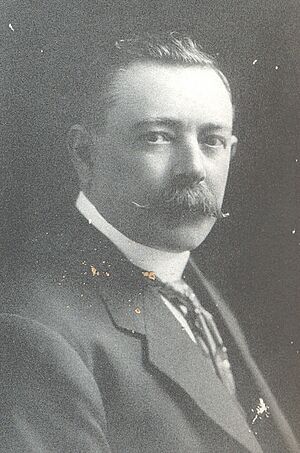George Elmslie (politician) facts for kids
Quick facts for kids
George Elmslie
|
|
|---|---|
 |
|
| 25th Premier of Victoria Elections: 1914, 1917 |
|
| In office 9 December 1913 – 22 December 1913 |
|
| Monarch | George V |
| Preceded by | William Watt |
| Succeeded by | William Watt |
| Leader of the Opposition of Victoria | |
| In office 22 December 1913 – 11 May 1918 |
|
| Premier | William Watt Sir Alexander Peacock John Bowser Harry Lawson |
| Preceded by | William Watt |
| Succeeded by | George Prendergast |
| In office 17 September 1913 – 9 December 1913 |
|
| Premier | William Watt |
| Preceded by | George Prendergast |
| Succeeded by | William Watt |
| Leader of the Labor Party in Victoria | |
| In office 17 September 1913 – 11 May 1918 |
|
| Deputy | John Billson |
| Preceded by | George Prendergast |
| Succeeded by | George Prendergast |
| Member of the Victorian Legislative Assembly for Albert Park | |
| In office 1 October 1902 – 11 May 1918 |
|
| Preceded by | John White |
| Succeeded by | Joseph Hannan |
| Personal details | |
| Born |
George Alexander Elmslie
21 February 1861 Lethbridge, Victoria, British Empire |
| Died | 11 May 1918 (aged 57) Albert Park, Melbourne, Victoria, Australia |
| Nationality | Australian |
| Spouse | Clara Ellen Williams (m. 1887) |
| Children | 2 |
| Profession | Stonemason |
George Alexander Elmslie (born 21 February 1861 – died 11 May 1918) was an Australian politician. He made history as the 25th and shortest-serving Premier of Victoria. He was also the very first Premier from the Labor Party in Victoria.
Contents
Early Life and Work
George Elmslie was born in Lethbridge, a town near Geelong, in 1861. Even though he went to high school, he chose to follow in his father's footsteps and became a stonemason. A stonemason is someone who cuts and shapes stone for buildings.
Building Famous Landmarks
George worked on some important buildings in Melbourne. These included the first Wilson Hall at Melbourne University and St Patrick's Cathedral. From 1888, he became an official for the Operative Stonemason's Society. This was a group that supported stonemasons. He also represented them at the Melbourne Trades Hall, a place where different worker groups met.
Involvement in Sports
Beyond his work, George was also the President of the South Melbourne Football Club. This club is now known as the Sydney Swans, a famous Australian Rules Football team.
Political Journey
In 1898, George Elmslie helped start the Victorian Labour Federation. This group wanted to unite all workers into one big union.
Joining Parliament
In 1902, he was elected to the Victorian Legislative Assembly. This is like the state parliament in Victoria. He represented the area of Albert Park as a Labor Party member. At that time, the Labor Party in Victoria was not as strong as in other Australian states. This was partly because many voters liked the ideas of another politician, Alfred Deakin. Also, Victoria didn't have as many large farming or mining areas, which often had strong Labor support.
Becoming a Leader
The Labor Party in the Victorian Parliament was quite small. George Elmslie became the deputy leader of the party in 1912. The next year, in 1913, he became the leader.
A Short Time as Premier
In 1911, the Labor Party only won 20 seats, while the Liberal Party won 43. But in December 1913, the Liberal Premier, William Watt, resigned. This happened after he had an argument with a group from his own party.
The acting Governor, Sir John Madden, surprised many people. He asked George Elmslie to form a new government. So, on 9 December 1913, George Elmslie became Victoria's first Labor Premier.
The Shortest Premiership
George Elmslie's time as Premier was very short. Back then, if a politician became a minister, they had to resign their seat and run in a special election again. This meant George couldn't sit in Parliament as Premier right away.
The different groups within the Liberal Party quickly joined forces again. William Watt then proposed a no-confidence motion against Elmslie. This is a vote to show that Parliament no longer supports the Premier. George Elmslie had to watch this vote from the gallery, as he wasn't officially a member of Parliament at that moment.
As expected, Elmslie's government was voted out. William Watt became Premier again on 22 December. George Elmslie's time as Premier lasted only 13 days, making it the shortest in Victoria's history.
Later Years and Legacy
George Elmslie remained the leader of the Labor Party until just before he passed away in 1918. His health had become poor in 1916, and he needed a long rest.
During World War I, George supported the Allied countries. However, he was against conscription, which meant forcing people to join the army to fight overseas. He died at his home in Albert Park and was given a state funeral, a special ceremony for important public figures.
For many years, George Elmslie was largely forgotten. But in the 1990s, a group called the Labor Historical Graves Committee found his grave. It was in the Melbourne General Cemetery and had been neglected. A new memorial headstone was placed on his grave. It was unveiled by Steve Bracks, who was the Labor Premier of Victoria at the time, on 9 March 2001.
| Political offices | ||
|---|---|---|
| Preceded by William Watt |
Premier of Victoria 1913 |
Succeeded by William Watt |

